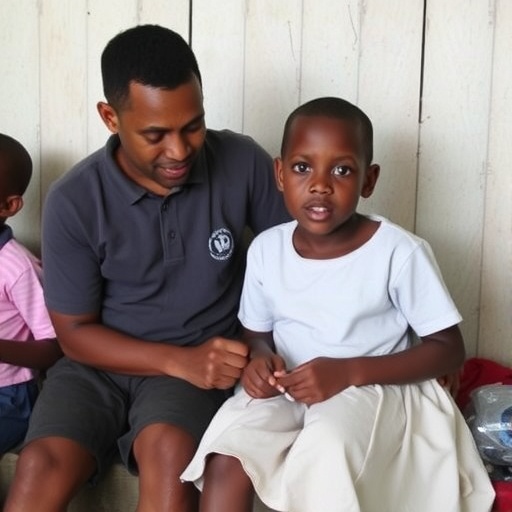In the tumultuous landscapes of the Vhembe district, an insightful new study explores the profound and multifaceted experiences of children exposed to trauma and violence. Conducted by Tsheole, Makhado, Maphula, and colleagues, this groundbreaking research sheds light on how early exposure to adversity shapes the psychological and social development of children, laying bare the urgent need for targeted intervention frameworks. Published in BMC Psychology, the investigation employs rigorous qualitative methodologies to delve into the lived realities of youth navigating the aftermath of violence—a subject often obscured by statistical abstractions and policy rhetoric.
The research confronts the pervasive issue of childhood trauma by capturing narratives that illuminate how violence permeates daily life and infiltrates the developmental trajectories of young minds. By situating the study within the Vhembe district, a region marked by socioeconomic challenges and fluctuating security conditions, the authors situate their findings within a localized but globally resonant context. This emphasis on lived experience moves beyond generic data to offer textured, nuanced perspectives—offering invaluable insights for psychologists, social workers, and policymakers aiming to devise culturally sensitive and effective therapeutic strategies.
Central to the study is an examination of the psychological mechanisms through which children process trauma and violence exposure. The findings reveal complex cognitive and emotional responses that encompass fear, hypervigilance, dissociation, and variations of resilience. This spectrum underscores the heterogeneity of trauma effects; not all children respond uniformly, highlighting the interplays of individual temperament, familial support structures, and community resources. The analysis underscores the importance of protective factors, such as stable caregiver relationships and safe social environments, as crucial buffers against the detrimental consequences of violence.
The methodology employed involves in-depth interviews complemented by participatory observation, facilitating a comprehensive understanding of children’s internal worlds. Through empathetic engagement, the research team captures the voices that often go unheard—children recount experiences filled with both harrowing pain and remarkable endurance. Such qualitative data enriches existing trauma literature by disrupting monolithic portrayals of victimhood and illuminating resilience as a dynamic process subject to context and personal agency.
Moreover, the study elucidates the multilevel effects of trauma exposure, extending beyond the individual to familial, educational, and community domains. For instance, children’s engagement in school is frequently compromised, as trauma manifests in concentration difficulties, absenteeism, and withdrawal—symptoms that cumulatively impede academic progress and social integration. The authors point to the cyclical nature of trauma propagation, cautioning that without intervention, these patterns may entrench and perpetuate cycles of violence and psychological distress across generations.
Intriguingly, the research highlights the role of cultural narratives and traditional practices in shaping trauma responses and coping mechanisms. In Vhembe, indigenous rituals and communal storytelling offer avenues for meaning-making and emotional release, serving as culturally congruent modalities for healing. This insight calls for holistic intervention models that respect and incorporate cultural strengths rather than imposing external frameworks disconnected from lived realities.
Furthermore, the study offers a critical lens on existing mental health infrastructure and its limitations in addressing childhood trauma in resource-constrained settings. The authors advocate for scalable, community-based interventions harnessing local knowledge, peer support networks, and capacity-building for caregivers and educators. Such approaches, they contend, are vital for creating sustainable ecosystems fostering resilience and psychological well-being in vulnerable populations.
From a neurological standpoint, the researchers discuss emerging evidence linking chronic trauma exposure with alterations in brain regions integral to emotional regulation, memory consolidation, and executive functioning, such as the amygdala, hippocampus, and prefrontal cortex. These insights reinforce the urgency of early detection and intervention, as neuroplasticity during childhood offers a window of opportunity to mitigate long-term cognitive and emotional impairments.
The research also grapples with the ethical complexities inherent in trauma studies, emphasizing the necessity of safeguarding participants through trauma-informed consent processes and ongoing psychological support. This attentiveness to ethical rigour enhances the credibility and humane quality of the inquiry, setting a benchmark for future investigations in similarly sensitive domains.
Importantly, the findings bear significant implications for global mental health discourse, particularly in post-conflict and socioeconomically marginalized regions. They challenge stakeholders to rethink conventional paradigms that often marginalize children’s voices and overlook the socio-cultural intricacies underpinning trauma experience. Consequently, this study contributes to a paradigm shift towards inclusive, contextually grounded mental health practices.
In conclusion, the work of Tsheole and colleagues offers a compelling, richly detailed account of children’s realities amid trauma and violence in the Vhembe district. By intertwining rigorous qualitative research with culturally attuned perspectives, the study paves the way for innovative interventions and policy reforms attuned to the nuanced needs of traumatized youth. This research not only advances academic understanding but also serves as a clarion call for concerted action to protect and empower vulnerable children worldwide.
As violence and its reverberations continue to challenge millions of children across diverse contexts, this study reminds us of the indomitable strength residing in vulnerable populations and the profound responsibilities borne by researchers, clinicians, and societies. The exploration of trauma’s lived experience thus becomes both a scientific imperative and a moral endeavor—one that compels empathy, action, and sustained commitment.
Subject of Research: The lived experiences of children in relation to trauma and violence exposure in the Vhembe district.
Article Title: Exploring the lived experiences of children in relation to trauma and violence exposure in the Vhembe district.
Article References:
Tsheole, P., Makhado, L., Maphula, A. et al. Exploring the lived experiences of children in relation to trauma and violence exposure in the Vhembe district. BMC Psychol 13, 1269 (2025). https://doi.org/10.1186/s40359-025-03602-2
Image Credits: AI Generated




